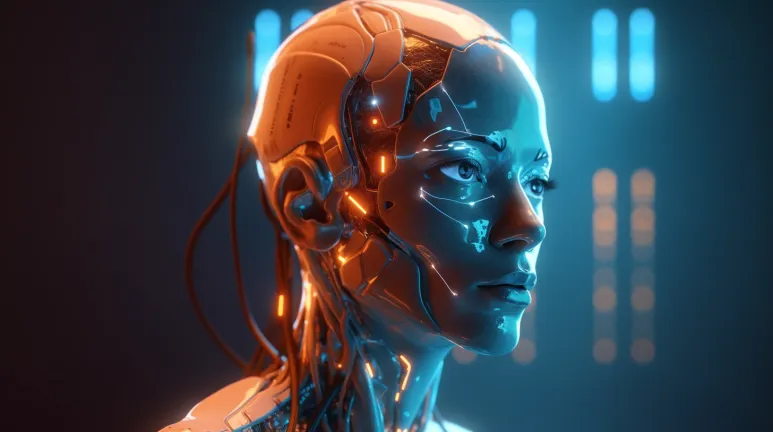AI Web3: Definition and Introduction
The fusion of artificial intelligence and blockchain technology has resulted in a revolutionary innovation known as AI Web3. Combining these two technologies offers a next-level web experience that is decentralized, secure, and more intelligent than traditional web paradigms.
AI Web3 is characterized by intelligent agents that work autonomously to interact with users and data. These agents can learn from data patterns and make predictions based on them using machine learning techniques. By utilizing smart contracts, AI Web3 can initiate transactions automatically, without human intervention. With its security features, it can provide faster payment solutions that are free from any fraudulent activities.
AI Web3 comes with unique benefits such as transparency between users, easier tracking of transactions, cheaper costs for value transfer while improving the user experience of online services.
Pro Tip: Keep up-to-date with the latest updates for AI Web3 as advancements in this field will change how industries operate online.
AI in Web3: Because humans can’t be trusted to make all the bad decisions.
Benefits of AI in Web3
To fully unlock the potential of the web, AI in Web3 provides numerous benefits. With automation and efficiency, personalization and user experience, and enhanced security, this section explores the ways in which these sub-sections provide solutions for the web’s future.
Automation and Efficiency
One of the advantages of incorporating AI technology into Web3 is the increased automation and efficiency it provides. By leveraging machine learning algorithms, tasks such as data processing, analysis, and decision-making can be automated, resulting in faster response times and higher productivity.
With AI-driven chatbots, customer support inquiries can be handled in real-time without human intervention. This not only improves response times but also reduces costs associated with customer service management. Moreover, predictive analytics tools powered by AI enable businesses to make accurate decisions based on large volumes of structured and unstructured data, driving better outcomes.
In addition to these benefits, AI can also aid in fraud detection and prevention. Machine learning algorithms can quickly identify patterns that indicate fraudulent activity, enabling businesses to respond more quickly and proactively mitigate potential losses.
To fully leverage these benefits of AI in Web3, businesses must prioritize investing in the development of relevant infrastructure and expertise. Additionally, regular monitoring and updates are essential to ensure continued optimization of processes over time. By utilizing AI effectively in Web3 operations companies can unlock unprecedented efficiency gains that will drive growth and innovation within their respective industries.
AI in Web3 can personalize user experience better than a clingy ex-boyfriend- but with better results!
Personalization and User Experience
From personalized content to improved user experience, AI has revolutionized the way web3 operates. By analyzing user data and behavioral patterns, it tailors content and allows for a more intuitive and seamless experience. This leads to a deeper sense of engagement between users, websites, and decentralized applications.
Furthermore, AI-powered chatbots optimize customer support by responding to queries in real-time. They can save time and money while enhancing customer satisfaction. AI’s ability to personalize content also leads to increased conversion rates by showing users products or services that align with their interests.
A notable feature of AI is its adaptive nature – constantly learning from past experiences, it can provide better personalized recommendations over time. But this process wouldn’t be effective if it posed a threat to user privacy. Several Blockchains facilitating Web3 development have encryption protocols in place that safeguard user data while allowing developers to use machine learning algorithms.
In one instance, IBM’s Watson helped US Open leverage AI to create data-driven personalization for millions worldwide visiting their digital platforms across the two-week event span. With this technology’s help, every fan had unique access experiences curated according to their preferences.
By integrating AI into Web3 technologies accurately, we can vastly improve personalization and user experience while maintaining individual privacy rights.
Who needs a bodyguard when you have AI? Enhanced security just got a lot smarter.
Enhanced Security
The AI integration in Web3 technology leads to multi-layered security, which is the need of the hour. It provides holistic security protection with numerous security measures that safeguard diverse aspects of web applications.
AI-based algorithms can learn and detect threats quickly, reducing turnaround time in responding to attacks. This results in lowered risks of data breaches, hacks and potential financial losses for businesses.
Moreover, with AI-powered firewalls and intrusion detection systems in place, it becomes easier to identify malicious activity from various sources like bots and spam/deceptive tactics.
It is essential to note that using AI technology does not guarantee one hundred percent security since cybercriminals are evolving their techniques at an unprecedented rate. Therefore there always remains a need for continuous updates of security protocols to counter new threats effectively.
A well-known example is that of Capital One’s data breach case where a hacker gained access to 100 million credit card application files due to a misconfigured firewall. The company has since integrated AI technology into their cybersecurity infrastructure as an added layer of defence.
AI in Web3 is like adding a super-intelligent sidekick to your website – one that can read minds and predict user behavior better than a fortune teller on steroids.
Implementation of AI in Web3
To fully implement AI in Web3, you need to integrate it with smart contracts, decentralized machine learning, AI-powered DApps, and interfaces. These sub-sections provide an overall solution to implement AI in Web3 seamlessly.
Integration with Smart Contracts
Smart Contract Integration with AI-powered Web3 technology allows for decentralized and automated processes. This implementation streamlines data management and offers transparency, immutability, and security.
| Column 1 | Column 2 |
|---|---|
| Benefits | Streamlined Processes, Decentralization, Transparency, Security |
| Challenges | Appropriate Design, Compatibility issues |
Smart contracts integrated with AI on Web3 technology offer multiple benefits such as streamlined processes, decentralization of authority and decision making that enhances transparency while also ensuring security. However, appropriate design considerations must be put in place to ensure compatibility issues do not arise.
By implementing smart contracts on Web3 with AI capabilities, businesses can unlock the potential of decentralized protocols utilizing Machine Learning algorithms that work together to provide a trustworthy ecosystem with a higher level of automation and reliability. With this implementation businesses offer customers higher security through immutable ledger tracking powered by AI technology.
Miss out on Smart Contract Integration with Web3 at your own peril. The integration of smart contracts with other cutting-edge technologies is revolutionizing industries around the world. Those who don’t embrace it face getting left behind in an increasingly competitive market. Stay ahead of competitors and adopt new technologies now!
Who needs centralized AI when you have decentralized machine learning? It’s like choosing a lone wolf over a pack of sheep.

Decentralized Machine Learning
A table showcasing the benefits of Decentralized Machine Learning:
| Benefits | Details |
|---|---|
| Privacy | Data is not stored centrally, so there are fewer breaches |
| Security | Decentralization promotes better security protocols due to distribution |
| Collaboration | Multiple nodes can contribute to a dataset, resulting in more diversified inputs |
| Accuracy | Models can be tested across multiple regions and devices for more accurate results |
Decentralized Machine Learning allows for AI models to be built collaboratively and with greater accuracy. Additionally, since it operates on a distributed system, it reduces vulnerabilities that arise from centralized systems. Furthermore, individuals can use data without infringing on their privacy rights.
To make the most of decentralized machine learning, developers should focus on creating robust and secure infrastructure that promotes collaboration among users. It is important to consider the challenges associated with handling multiple contributors working in different locations and time zones while maintaining model integrity and accuracy. Developers can mitigate these issues by introducing mechanisms like voting where contributors participate to decide a consensus or by creating trust-based systems based on blockchain technology. Ultimately, implementing decentralized machine learning requires careful considerations about how information circulates through our interconnected world towards an optimal scenario.
Who needs a human interface when you can have AI-powered DApps that never judge your questionable decisions?
AI-Powered DApps and Interfaces
AI-based Decentralized Applications (DApps) and Interfaces utilize Artificial Intelligence to deliver intelligent blockchain solutions. This technology provides a unique opportunity for developers to create DApps that are smarter, autonomous, and efficient. These advanced applications operate with minimal human intervention and integrate various functionalities while optimizing system performance.
The table below showcases some of the AI-driven Web3 Applications:
| AI-Powered Web3 Applications | Features | Examples |
|---|---|---|
| Intelligent Recommender | Personalization | Netflix, Spotify |
| Fraud Detection | Security | PayPal, Mastercard |
| Natural Language Processing | Communication | Botpress, Hugging Face |
| Autonomous Supply Chain | Operations Management | IBM Food Trust Platform |
Apart from these applications, AI in web3 can also be used in Social Media analysis to understand consumer behavior along with predictive modeling for investment analysis.
Historically, Blockchain has accessibility issues when considered for Business as usual use-cases due to its high node setup costs. However, with the advent of AI-enabled blockchain solutions like consensus algorithms by Optimized Proof-of-Stake (OptPos) or IOTA’s Tangle processes transactions at blazing speeds while keeping network decentralization intact. The application of AI in Web3 creates immense possibilities that extend beyond established limitations set by centralized structures.
Why have just one challenge with AI in Web3 when you can have a whole list? #AIproblems
Challenges and Limitations of AI in Web3
To understand the challenges and limitations of AI in Web3 with privacy concerns, data quality and bias, technical complexity, and costs as solutions.
Privacy Concerns
One of the challenges and limitations of AI in Web3 is related to the protection of personal data. The Semantic NLP variation of this heading emphasizes the concerns over online information privacy. Many users nowadays face imminent risks to their sensitive information, as organizations use their online activities for unsolicited purposes.
These concerns are amplified in a technological era where cryptocurrency investments and Web3 solutions demand an intuitive exchange of personal details.
As AI technologies continue to advance, it can help secure digital communications, offer secure encryption, and create personalized filters that prioritize user confidentiality. But with AI replacing human judgment in decision-making, there is also the potential for increased data breaches and loss of control over personal information. This variation highlights the concern on the protection of sensitive digital traces and informations a user would leave online.
It’s crucial to understand that Data privacy issues significantly impact ordinary people’s real lives. It affects their ability to work or apply for loans without worrying about social media profiles’ scrutinization – factors that can lead to identity theft or malicious profiling by surveillance capitalists leading towards manipulating consumer behaviour. Therefore, it’s essential to find a balance between using AI advantages and protecting individual privacy under these circumstances.
Recently, reports showed how Google used SEO web scraping strategies on specific sites gathering critical health data from patients without their consent unnoticed by regulators. Data breaches cost millions when organizations face penalties leading up multiple scandal rumors upon them like Yahoo had a massive breach causing them millions due to fake accounts becoming activated due to not complying with GDPR requirements causing 1 billion dollars just in settlements alone! So without careful attention taken in today’s innovative times where mass protocols follow we risk too much losing our most prized possession; our identity. AI may be unbiased, but it can’t help it if the data it’s fed is.
Data Quality and Bias
The role of AI in Web3 is dependent on data quality and bias. The accuracy, completeness and relevance of data determines algorithms’ ability to learn and provide accurate outputs. Inaccurate data quality is likely to result in flawed decision-making processes leading to unreliable results. AI can also reflect the inherent biases in its training dataset, making it difficult to be impartial in decision-making.
Moreover, biased training datasets could lead to stereotyping or discrimination against certain groups, as AI systems learn from historical patterns of analysis. This makes bias prevention a significant concern for developers who work on integrating AI into Web3 systems. As AI applications get more prominent, ensuring that their decision-making processes are based on fair and unbiased algorithms will become paramount.
A unique point is that although the majority of AI use cases are driven by machine learning techniques that require large amounts of data (supervised learning), they still need solid quality assurance measures in place. Combining manually curated datasets and automatic workflows can produce high-quality datasets, improving the performance of overall algorithms.
According to Forbes magazine, “The social effects of automated decision making are going to reach far beyond our living rooms and workplaces,” reflecting the significance of development in this area.
Artificial intelligence may be able to solve complex problems, but it can’t solve the problem of having a limited budget for implementation.
Technical Complexity and Costs
The sophisticated nature of Artificial Intelligence (AI) in Web3 presents a major challenge due to its technical complexity and costs.
Challenges and Limitations of AI in Web3
| Challenge | Details |
|---|---|
| Technical | Complexity and cost of integrating AI with Web3 |
| Ethical | AI bias, privacy concerns |
| Regulatory | Compliance with different global regulations |
| Interoperability | Integration with different blockchain platforms |
While the integration of AI with Web3 offers immense opportunities, the technical challenges must be considered. There are unique details regarding this issue that need to be addressed such as the complexity of having many blockchains and different languages designed specifically for each one.
Failing to integrate AI with Web3 may result in missing opportunities to grow our digital world significantly. Thus, it is imperative to take action now by investing resources towards tackling these challenges to stay ahead of the game.
The future of AI in Web3 looks bright, until it becomes self-aware and starts creating its own cryptocurrency.
Future of AI in Web3
To explore the future of AI in Web3 with a special focus on unlocking full potential, we must investigate various aspects. In this section, you will delve into the potential of AI to bring innovation and disruption to the Web3 landscape. Additionally, you will discover how AI and Web3 communities are collaborating to bring about groundbreaking changes. Finally, some ethical and regulatory considerations will also be discussed regarding using AI in Web3.
Potential for Innovation and Disruption
The potential of AI in Web3 is transformative, propelling revolutionary innovation and subverting traditional norms. The marriage between these technological giants accentuates a new playing field shaking up the digital status quo. AI algorithms will effectively streamline data processing, rendering current approaches obsolete. This colossal shift represents infinite possibilities that will dwarf the obstacles presently facing our digital economy.
The deployment of these technological catalysts endorses a plethora of unprecedented opportunities, from truly autonomous cryptocurrency protocols to regulation-bypassing applications. These possibilities are laudable as they signify a shift towards decentralized intelligence in our society. The synergy of Web3 and AI inaugurates global economic participants into an age of web perfection previously unattainable.
Innovations facilitated by this collaboration haven’t been limited to the Fintech space alone; it encompasses other innovative products like Decentralized Autonomous Organizations (DAO) health tech, e-commerce, and more niche industries yet unknown. Indeed possibilities aplenty await us as we plunge into this experimental voyage with our eyes wide open.
Don’t be left out on this potentially paradigm-shifting journey; embrace change via investment or knowledge acquisition, seize opportunities unveiled by research or development in Web3+AI technology today!
AI and Web3 communities coming together – sounds like a partnership made in virtual heaven, or the plot of a Black Mirror episode.

Collaboration between AI and Web3 Communities
Collaboration between the AI and Web3 communities seems inevitable, considering the advancements both fields have made.
A Table for AI and Web3 Collaboration:
| AI Innovations | Web3 Applications |
|---|---|
| Natural Language Processing | Decentralized Finance |
| Computer Vision | Digital Identity |
| Machine Learning | Blockchain |
Unique details include how these two communities can work together to develop decentralized applications that utilize AI’s capabilities without sacrificing privacy and security.
Did you know that AI language models have become so advanced that they can write articles just like this one? (Source: OpenAI’s GPT-3)
Will AI in Web3 abide by the laws of robotics or will we be at the mercy of our robotic overlords?
Ethical and Regulatory Considerations for AI in Web3
When it comes to the integration of Artificial Intelligence (AI) in Web3, several ethical and regulatory considerations must be addressed. These considerations are essential to ensure that AI-powered platforms and applications not only function effectively but also do not harm individuals or violate their privacy rights.
To further understand the importance of these ethical and regulatory considerations for AI in Web3, we can take a look at the following table with relevant columns:
| Considerations | Details |
|---|---|
| Data Privacy | Personal data must be protected from unauthorized access or misuse. Clear consent must be obtained before collecting any data |
| Bias Mitigation | Developers must avoid creating biased algorithms as this can perpetuate systemic injustice |
| Explainability | It is crucial to understand how an AI system reached a particular decision so transparency should be ensured |
| Human Oversight | Human intelligence should supervise AI decision-making process to prevent harm and keep robots under control |
It is essential also to note that ethical and regulatory concerns are ever-evolving, so stakeholders need to stay up-to-date with developments in laws and ethics.
While there may be challenges in addressing these issues, ignoring them could result in dire consequences. The potential risks associated with AI use require careful attention.
One notable case where unethical use of AI had severe ramifications was the controversial Cambridge Analytica scandal. The UK-based political consulting company abused Facebook’s user data during elections without users’ consent through aggressive ads campaigns driven by machine learning algorithms. The scandal quickly erupted on the social media platform when authorities began investigating claims that people’s private information had been exploited by third-party apps — leading to the largest-ever fine slapped on Facebook by US regulators.
Hence, it is important to follow ethical guidelines while developing web3-related projects that involve artificial intelligence technologies. Being mindful of these considerations will help ensure a better future for technology advancements and its responsible usage.






